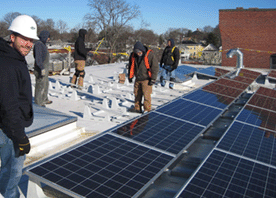 When considering a new roof-mounted commercial solar project our engineers need to quickly address key financial questions such as “in which state is your facility? (ie. is there a strong state rebate) and “will you be buying or financing it?” (ie. solar PV still sits outside normal corporate ROI hurdles). If both these answers are affirmative the next question we focus on is the age and type of the existing roof.
When considering a new roof-mounted commercial solar project our engineers need to quickly address key financial questions such as “in which state is your facility? (ie. is there a strong state rebate) and “will you be buying or financing it?” (ie. solar PV still sits outside normal corporate ROI hurdles). If both these answers are affirmative the next question we focus on is the age and type of the existing roof.
A few years ago we performed site visits for adding solar thermal to a series of multi-unit homes. We had gathered data on their historical fuel costs, the type and efficiency of their existing boilers, had a design for the pipe runs connecting the panels and heat exchanger, had determined the optimal orientation of the panels relative to tree shading and had run our energy models with all this data.
In the end their 10 year old EPDM roof made the whole project hard to pull together. At 10 years their roof was too new to require a replacement but too old to support an additional 25 year life span for a solar thermal installation. The project would be burdened with the new roof cost but there would be no financial return for this upgrade. These days we’re a little more sophisticated before we get in a truck for a site visit!
Recently we’ve seen solar technologies which can have an added financial incentive addressing this roof issue. With commercial thin film solar, because a new roof membrane comes with the installation, a portion of the system cost can be included in the Federal Investment Tax Credit – effectively a tax incentive for a new roof. This can also be the case with technologies like Solyndra, which require a white roof for the system to operate effectively and hence take this pro-rata tax benefit when calculating their financial return. Of course, you must be careful to confirm with your (or your financier’s) accountants on their interpretation for your installation.
So perhaps going forward there will be a better opportunity to apply this value in the corporate financial analysis for adding solar. In addition to solar PV systems serving as a (1) a long term energy price hedge, (2) a greening corporate statement and (3) a potential mechanism for carbon tax savings, perhaps our corporate customers will soon begin to look at this opportunity principally as a cheaper way to replace their aging roofs?

